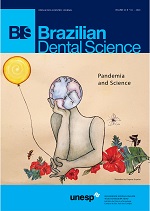Prevalence of soft tissue calcifications in cone beam computed tomography images in the region of head and neck
DOI:
https://doi.org/10.14295/bds.2020.v23i2.1864Resumo
Objective: to evaluate the prevalence of calcifications in the soft tissues of the cervical-facial region using cone beam computed tomography (CBCT) images. Material and Methods: two hundred and ten CBCT exames was analyzed by 01 examiner previously trained, with fild of view (FOV) of 16 x 13 cm and voxel of 0.25 mm, in ICAT Vision software (Imaging Science International, Hatfield, PA, USA) in coronal, axial and sagittal sections. The following calcifications were evaluated: tonsiloliths, sialolites, calcification of the styloid complex, calcified carotid atheromas, calcifications in laryngeal cartilages, calcified lymph nodes and osteoma cutis. The findings were tabulated according to the total of the sample, related to the gender, age group of the individuals. Results: Calcification of the styloid complex was the most frequent in the sample studied in both genres (39.04%), followed by the presence of tonsiloliths (19.52%), and calcified lymph nodes (6,67%). Conclusion: calcifications are frequent radiographic findings in CBCT and important for the diagnosis of some possible pathologies that do not present clinical symptoms.
KEYWORDS
Cone-beam computed tomography; Prevalence; Soft tissue calcification.
Downloads
Downloads
Arquivos adicionais
Publicado
Como Citar
Edição
Seção
Licença
TRANSFERÊNCIA DE DIREITOS AUTORAIS E DECLARAÇÃO DE RESPONSABILIDADE
Toda a propriedade de direitos autorais do artigo "____________________________________________________________________" é transferido do autor(es) para a CIÊNCIA ODONTOLÓGICA BRASILEIRA, no caso do trabalho ser publicado. O artigo não foi publicado em outro lugar e não foi submetido simultaneamente para publicação em outra revista.
Vimos por meio deste, atestar que trabalho é original e não apresenta dados manipulados, fraude ou plágio. Fizemos contribuição científica significativa para o estudo e estamos cientes dos dados apresentados e de acordo com a versão final do artigo. Assumimos total responsabilidade pelos aspectos éticos do estudo.
Este texto deve ser impresso e assinado por todos os autores. A versão digitalizada deverá ser apresentada como arquivo suplementar durante o processo de submissão.




























